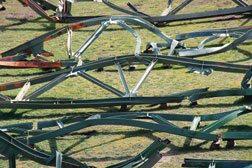 AP / Wideworld Investigators found 16 fractured gusset plates at eight nodes.
|
As a result of those findings, NTSB recommended the U.S. Dept. of Transportation direct states to include effects on gusset plates as they do their bridge load calculations, and DOT quickly issued a technical advisory.
|
During its wreckage recovery, the on-site NTSB investigative team found 16 fractured gusset plates at eight nodes, or joints, in the bridge’s main center span. Rosenker said the damage patterns and fracture features uncovered in the investigation “suggest that the collapse of the deck-truss portion of the bridge was related to the fractured gusset plates and, in particular, may have originated with the failure of the gusset plates at one of those eight nodes.” A construction crew performing modifications on the bridge was working near one of the nodes where there were two fractured gusset plates.
But Rosenker noted that it is too early to draw definitive conclusions. “I want to make it clear that we have not yet determined the probable cause of the accident,” he said. Although it is likely the weakened gusset plates played a role, the investigative team hopes to issue its final report with a probable-cause finding in early fall.
|
|
In all, the bridge had 224 gusset plates that connected steel beams at 112 joints, with two plates at every node. Although 16 of the gusset plates were fractured, the other major gusset plates in the main trusses were generally intact.
NTSB and the Federal Highway Administration subsequently conducted a review of the design of the bridge, focusing on the design of the gusset plates. The investigation revealed that 16 gusset plates in the center span of the bridge “were too thin to provide the margin of safety expected in a properly designed bridge such as this,” Rosenker said.
The investigators also tested the materials used in the plates, but found no deficiencies in the quality of the steel or concrete used in the bridge. Additionally, NTSB said that corrosion or deterioration of the bridge were not likely factors in the collapse.
 Tudor Van Hampton / ENR |
 AP / Wideworld NTSB will issue definitive conclusions this fall.
|
The bridge was designed by the now-defunct St. Louis-based Sverdrup & Parcel, which was acquired by Pasadena, Calif.-based Jacobs Engineering during the 1960s. Rosenker said that the error most likely occurred during the design process, although the original calculations used to develop the design of the gusset plates have not been found.
“NTSB clearly stated...the original design flaw was unrelated to subsequent inspections or maintenance of the bridge,” said Minnesota Gov. Tim Pawlenty (R). He also said he had directed the Minnesota Dept. of Transportation to recalculate the load capacity on the state’s 23 main highway bridges with designs similar to the I-35W bridge.
“Although the NTSB has not determined the cause of the bridge collapse, it has uncovered an important piece of evidence,” said House Transportation and Infrastructure Committee Chairman James Oberstar (D-Minn.). “We are still waiting to see if delayed or deferred maintenance may have also played a role in the collapse. Additionally, the unusually heavy loads of construction equipment and vehicle traffic on the bridge that day may have also been contributing factors.”
Oberstar’s committee cleared a bill on Oct. 31 that would authorize $2 billion over two years to replace or repair deficient bridges nationwide and also mandate tougher inspection standards.
It appears the design miscalculation on the Minnesota bridge was an isolated incident, but the possibility exists that a similar error could have occurred on other bridges. NTSB recommended FHWA require owners planning modifications to non-load-path-redundant steel-truss bridges perform load calculations to verify that stress levels on all structural elements, including gusset plates, remain within design requirements.
The American Association of State Highway and Transportation Officials supports the NTSB recommendation and FHWA’s technical advisory, “as well as any additional recommendations that may be issued when the investigation is completed,” says AASHTO Executive Director John Horsley.
“It is our understanding that this tragic incident is a unique event, and that there is no reason to believe that the deficiencies identified in the design review of the bridge are widespread or even go beyond this particular bridge,” Horsley added. “The collapse could not have been detected by bridge inspections nor is it a result of deterioration. No field reviews or inspections of bridges are being recommended.”
NTSB says there are 465 bridges across the U.S. that are similar in design to the Minnesota bridge.
lthough the final cause of the Aug. 1 Interstate-35W bridge collapse in Minnesota has yet to be determined, National Transportation Board Chairman Mark V. Rosenker says investigators have found a design miscalculation that may have been central to the bridge’s collapse. Rosenker said on Jan. 15 that 16 of the gusset plates in the bridge’s main center span were roughly “half the thickness that would be required,” approximately 1⁄2 in. thick rather than 1 in. thick.
 Related Links:
Related Links: 
Post a comment to this article
Report Abusive Comment